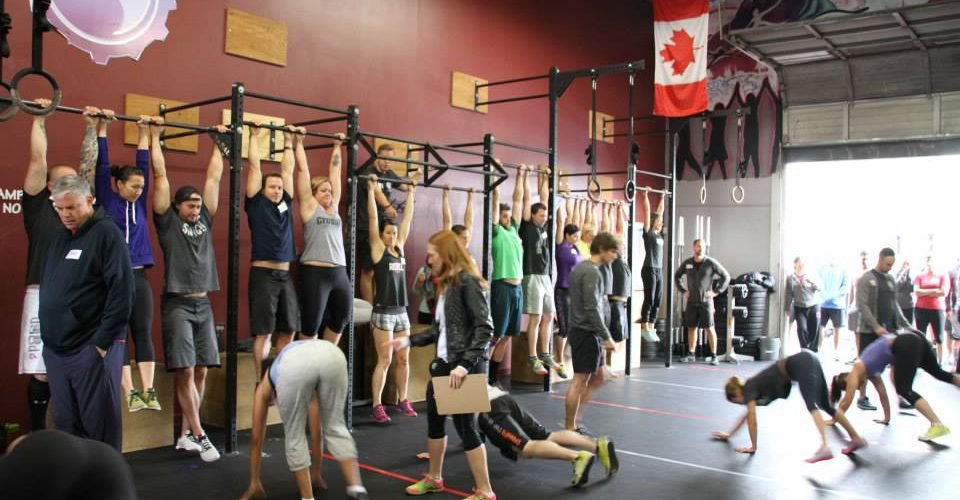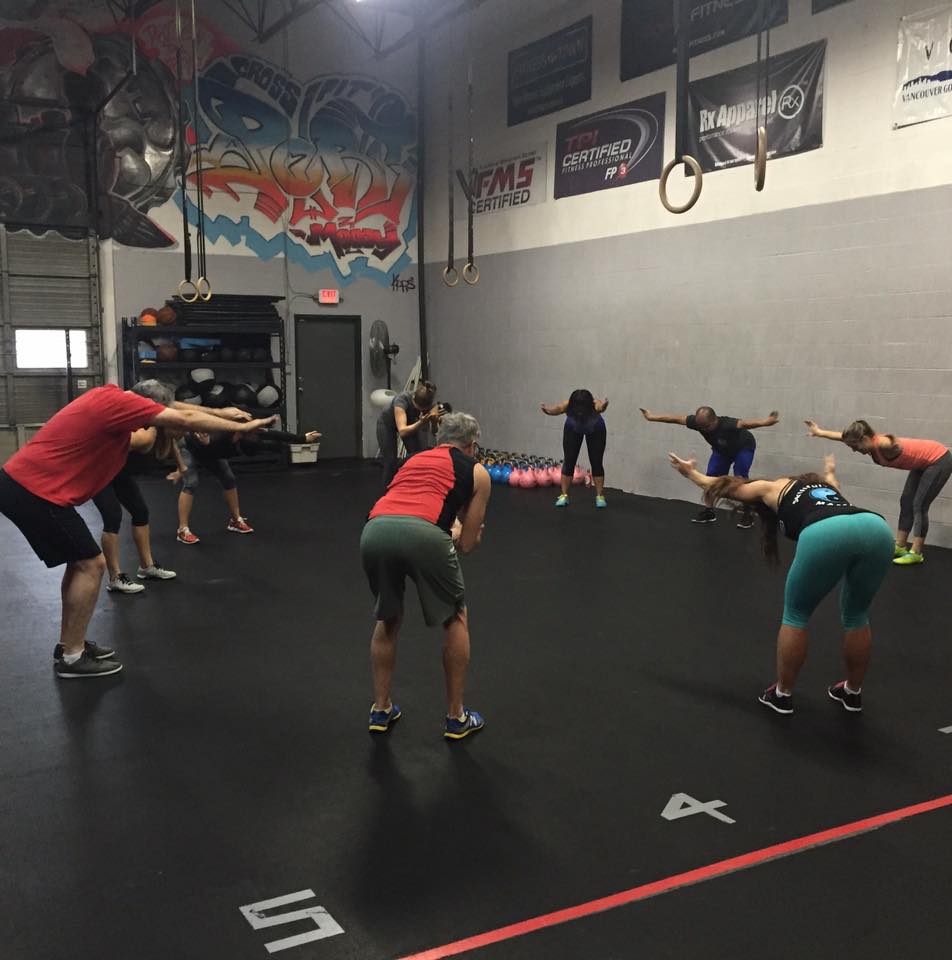Do we even CrossFit bro?

So what exactly is CrossFit and are we actually a CrossFit box? I’ve been told by some that we aren’t and I’ve also heard that I should just drop the CrossFit Port Moody affiliate name all together. Do you know what CrossFit is? Read on and find out.
 Engineered Bodies Strength & Conditioning – Ruben’s Throwdown 2.0, Workout 1
Engineered Bodies Strength & Conditioning – Ruben’s Throwdown 2.0, Workout 1
CrossFit is defined by CrossFit HQ as the following:
“constantly varied, functional movement at high intensity”
Constantly varied means one should train and prepare for the unknown and unknowable (random physical challenges). Functional movement defined by CrossFit is anything that uses multi-joint movement patterns. High intensity defined by CrossFit is power (i.e. going fast as possible with PROPER FORM).
That does not mean every workout of the day (WOD) has to have the classic CrossFit girl-named benchmark workouts programmed all the time. It also doesn’t mean one needs to do high-repetition, Olympic weightlifting movements in a WOD to be considered training CrossFit. It also doesn’t mean CrossFit Hero WOD’s need to be programmed often either.
If a coach follows the definition of what CrossFit is, then a typical WOD could be:
10min AMRAP of:
10 burpees,
20 wall balls,
50 double unders,
or
4-rounds for time (15min CAP)
10 EKG quad sprawl + leg through + squat jump
15 strict pull-ups,
20 thrusters (115/105)
These above examples use functional movements and you are expected to execute them at high intensity with proper form. In a nutshell, true CrossFit programming clumps movements into three groups: cardio, gymnastics, and weight training. Cardio could be running 3km, rowing 500m, or doing 300 double unders. Gymnastics movements are mainly body weight movements like push-ups, pull-ups, muscle-ups, press-to-handstand, air squats. Finally, weight training movements are Olympic lifts, Kettlebell swings, squats, deadlifts.
A “hopper model” is a programming methodology used by some CrossFit boxes to select exercise movement patterns in each of these groups in a random fashion to make up the WOD.

The essence of this model is the view that fitness is about performing well at any and every task imaginable, whenever. Picture a hopper loaded with an infinite number of physical challenges where no selective mechanism is operative, and being asked to perform feats randomly drawn from the hopper. Any week of training could be this:
Monday: 4-rounds of 10 deadlifts at 225lbs, 20 box jumps, 30 over the bar burpees,
Tuesday: 30 clean and jerks for time, 60 pull-ups,
Wednesday: 10 x 1 back squats at 95%1RM
Thursday: 150 wall balls,
Friday: 3km, 300 double unders, 3000m row,
The next week could be completely different. It all depends on what ball is pulled out of the hopper. That’s true CrossFit programming. It’s constantly varied and is 100% meant to be random. Be ready for the unknown and unknowable they say! The methodology definitely produces a quick improvement in fitness for those unfit for CrossFit (i.e. CrossFit newbies) but after a while, one becomes conditioned for that style of training only. In other words the improvement has a ceiling. Random programming and exercise selection does not give your body enough time to adapt to any sort of training stimulus. The unfortunate byproduct of random programming is that it is difficult to focus on training your weakness so you can’t get stronger and actually improve on a skill that you might severely be lacking in.
Why does this happen? The answer is simple. If a person is constantly training to complete the workouts as fast as possible then the nervous systems becomes conditioned to only go fast. This is why you see CrossFit regional level athletes that have competed in CrossFit for years who still lack a strict ring muscle up or strict handstand push-ups. That athlete’s programming got them to be good at going fast but lacked the focus to build the strength, skill, and mastery of the movement they could’ve been lacking in. Instead they trained a cheat version of that movement for the sake of going fast (most likely kipping). This is also why you see a large majority of regional and games athletes wearing so much Rock Tape or Kinesio-tape to hold their bodies together. Those athlete’s program unfortunately may have not properly used the appropriate progressions necessary to condition the joints and soft-tissues to prepare their body for strength and eventually speed work.

A good coach understands that strength training, progressions, and periodization (i.e. a systematic training plan) must be the foundation for programming for both the general population and the CrossFit athlete and it will integrate elements of CrossFit methodology systematically into that programming when appropriate. The main difference between programming for the general population and for the CrossFit athlete would be the timely inclusion of more CrossFit, sport-specific movements like high-rep O-lifting, kipping pull-ups, kipping muscle-ups, or high rep box jumps for the CrossFit athlete.
When programming is designed in this manner, people have time to adapt to the main strength training element of the programming and will actually get stronger. Training like this will also reduce one’s risk to injury because there are lower intensity days programmed into the week and there are recovery (de-load) weeks programmed every two to three weeks to give the nervous system and body time to recuperate and regenerate. When people get stronger, it’s easier to get the body conditioned to go faster in CrossFit style workouts (if speed to complete random tasks is a goal we actually want to consider training for). Increased strength allows people to accomplish most any task easier than if they only had a body conditioned to go faster.
So do we train CrossFit? The answer is yes!
However a more accurate description of what you train at Engineered Bodies is:
periodized strength training that integrates CrossFit principles systematically within the program.
EB’s programming is designed for you to be able to attend everyday in the week and will provide you with a consistent increase in strength and improved general fitness for as long as you want to train (hopefully forever). Our programs integrate other movement classes like Mobility Strength which uses the Ido Portal Method Corset protocols to improve our client’s joint range of motion and strength within that new range.

It’s proven to work for our community if you commit to the process and train consistently during the week. If you only come once or twice a week, the results will be random and limited. My advice is for you to pre-schedule your workouts in the week and aim for a minimum of 3 days per week at the start of your training and eventually build up to 4-5 days a week of training to really see the benefits.
**Look at the white board to get a sense of what the training focus will be during the week so you can plan ahead according to your personal fitness goals**
There will be times in a program where it may seem that the workout isn’t one where you leave the gym in a sweaty mess. There may also may be times where there isn’t a whole lot of variety in the movements. That’s by design and that time period may only be for a stretch of a few weeks (4 weeks at the most). Remember there is a reason for that and it will be realized in time if you’re consistent and patient to the process and the journey of your own continuous improvement, development, and growth. It’s not a destination to get to as fast as possible.
Please let me know if you ever have any questions and enjoy the process!
Coach Anthony

